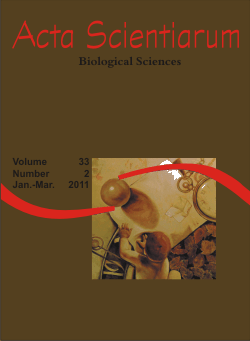<b>The impact of oxygen consumption by the shrimp <em>Litopenaeus vannamei</em> according to body weight, temperature, salinity and stocking density on pond aeration: a simulation</b> - doi: 10.4025/actascibiolsci.v33i2.7018
Keywords:
Aeration, shrimp farming, respiration, oxygen consumption, density
Abstract
A simulation was conducted to determinate the impact caused by the combination of Litopenaeus vannamei respiratory rate (mg O2 shrimp-1 h-1), the behavior of SOTR (kg O2 h-1) of mechanical aerators as a function of salinity, as well as the oxygen consumption rate of the pond water and soil (mg O2 L-1 h-1) on the aeration of shrimp ponds (1, 10, 50 and 100 ha) stocked with different densities (10, 40 and 120 shrimp m-2), salinities (1, 13, 25 and 37 ppt), temperatures (20, 25 and 30°C), and shrimp wet weight (5, 10, 15 and 20 g). Results showed that under lower salinity, with larger shrimp, and higher stocking density, higher will be the quantity of required 2-HP aerators to keep dissolved oxygen over 50% saturation. In addition, under low salinity, with 5 and 10 g shrimp, independent of stocking density, more aerators per hectare are required and electricity cost is higher at 20°C and salinity 1 ppt. Less aerators and lower electricity cost was observed at 30°C, salinities of 25 and 37 ppt, and shrimp of 15 and 20 g.Downloads
Download data is not yet available.
Published
2011-05-16
How to Cite
Vinatea, L., Muedas, W., & Arantes, R. (2011). <b>The impact of oxygen consumption by the shrimp <em>Litopenaeus vannamei</em> according to body weight, temperature, salinity and stocking density on pond aeration: a simulation</b> - doi: 10.4025/actascibiolsci.v33i2.7018. Acta Scientiarum. Biological Sciences, 33(2), 125-132. https://doi.org/10.4025/actascibiolsci.v33i2.7018
Issue
Section
Aquiculture and Fisheries Resources
DECLARATION OF ORIGINALITY AND COPYRIGHTS
I Declare that current article is original and has not been submitted for publication, in part or in whole, to any other national or international journal.
The copyrights belong exclusively to the authors. Published content is licensed under Creative Commons Attribution 4.0 (CC BY 4.0) guidelines, which allows sharing (copy and distribution of the material in any medium or format) and adaptation (remix, transform, and build upon the material) for any purpose, even commercially, under the terms of attribution.
Read this link for further information on how to use CC BY 4.0 properly.
0.6
2019CiteScore
31st percentile
Powered by 

0.6
2019CiteScore
31st percentile
Powered by 











1.png)




3.png)













